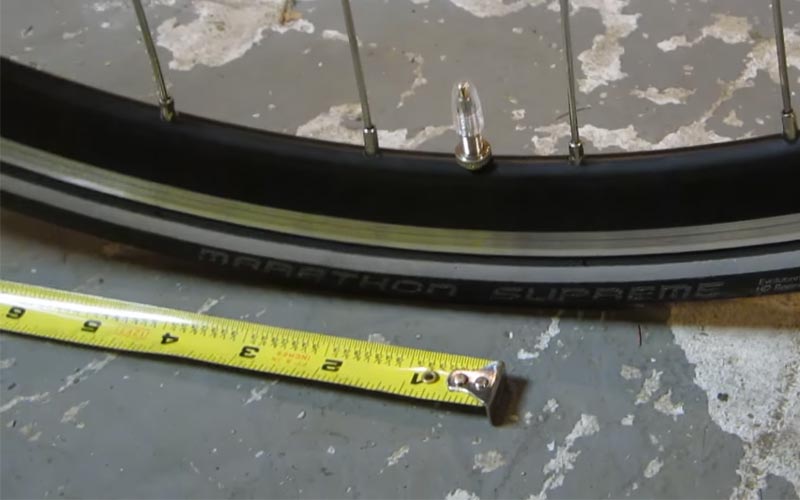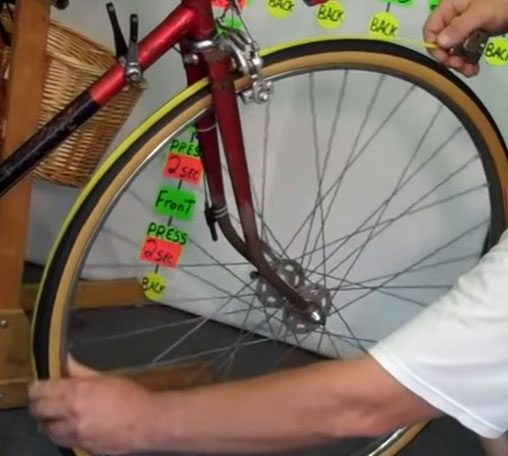
The tires are the most important part of the bike since you can’t get anywhere without them. Speedometers and cycling computers are often used by frequent bikers to give them an idea of how far they’ve traveled by bike – as well as other important bike stats.
So, how will the gadget accurately measure your bike mileage and everything else? If you’re looking for an accurate way to count your achievements on a cycling computer, you will need to accurately measure your bike tire.
See also:
In this guide, we will show you how to measure your bicycle tire to help you get the correct stats for your cycling computer. In this way, you will know what to input to your gadget of choice the next time you ride your bike.
Contents
How to Measure a Bike Tire
Here are the steps to measuring a bike tire:
1. Set the bike or bike tire properly
If you have a bike stand, you can use it to measure the circumference. However, for measuring the diameter, we suggest making the bike stand on its own to the ground. The important element is to get a clear view of the bike tire. We suggest having adequate lighting for the measurements to be clearer.
For other measurements, such as if you need to roll out the bike tire, ensure that you properly detach the bike wheel and be sure to keep the screws in one place to avoid losing or misplacing them. You may also need to have a flat surface to roll your tire on properly.
2. Measure the circumference
The circumference is the measurement of the bike tire all around. To make this measurement, simply wrap your tape measure from one point of the tire to the other end. This will be quite tricky since you might end up making the tape slip off.
To avoid this kind of slippage, we suggest having a partner to help hold the tape around it so that the measurement will work out (and will be as accurate as possible). If you don’t have anyone, you can put some sticky tape over the tape measure to make sure it stays in place.

Another way to measure the circumference is to use the tire valve as a marking point. On the floor, place the area with the valve straight to the floor and mark it with any object you like. Roll the bike tire straight forward (or backward) until the valve makes a complete turn and then mark that end.
Once you’ve gotten both the beginning and ending points of the bike tire using the valve as a marker, it’s time to measure it. Simply lay your tape measure from one point to the other and take the measurements.
One more way to find out about the circumference is to simply do some math. Multiply the diameter of the bike tire by 3.14 (value of Pi). For instance, if you have a bike that measures 27 inches for its diameter, you will get 84.78 inches or 215.34 centimeters.
You can use either metric or imperial for measuring. For metric, typically, millimeters are used for measuring (not centimeters) but you can simply convert it to centimeters by moving the decimal place by one backward and rounding off the decimal number.
3. Measure the diameter
To get the diameter of a bike tire, ensure that your bike tire is touching the ground. Simply measure the distance from the ground to the center of your tire – this number is only half the diameter. You will need to multiply it by 2 to get your diameter.
Bike tires are often measured in inches for the diameter. For instance, a 26-inch bike tire would have a 13-inch radius or half-diameter. Measuring the diameter is often done if the sidewall of your bike tire doesn’t indicate the diameter and you have no idea what the diameter is.
4. Measure the bike tire width
The width of the bike tire is the distance covered by the tire tread. As we mentioned above, not all tires are the same since some are specifically made for various terrains and riding styles. Wide tires are typically used for off-road biking and vice-versa for road bikes.
The bike tire is typically measured in inches but if you need to measure it with the ISO system, simply convert the inches into centimeters or millimeters.
Q&A
Here are some commonly asked questions about bike tire measurement:
Yes, measuring the wheel size of a bike includes the tire. Although there are different types of tires with varying thicknesses, measuring your bike wheels generally includes the tire – especially if you are manually measuring the circumference. For very fat tires, you might need to ask a bike expert.
In most cases, yes, the wheel size of a bike can also be its size. However, frame size is used for bicycles that have mostly a standard measurement, such as those with more than 26-inch wheels. When in doubt, ask the bike shop owner about bike sizing.
That depends on whether or not your bike has enough clearance for a 26-inch wheel. Moreover, using a bigger wheel size like this is only suitable if your bicycle runs on a disc break instead of a traditional rim brake due to the incorrect sizing.
Bike sizes can be different with various types of bikes. Standard and bigger bikes, for instance, will have a different “bike size” that’s not the wheel or tire size. Instead, they will use frames to indicate bike size (commonly used for road bikes).
Conclusion
To wrap it up, bike tire sizes vary depending on the model and the type of bike you have. While some use the tire sizes as the bike size, others use the frame instead. Whatever your purpose is – especially for a bike computer or a speedometer – proper and accurate bike tire size is important to know about.









